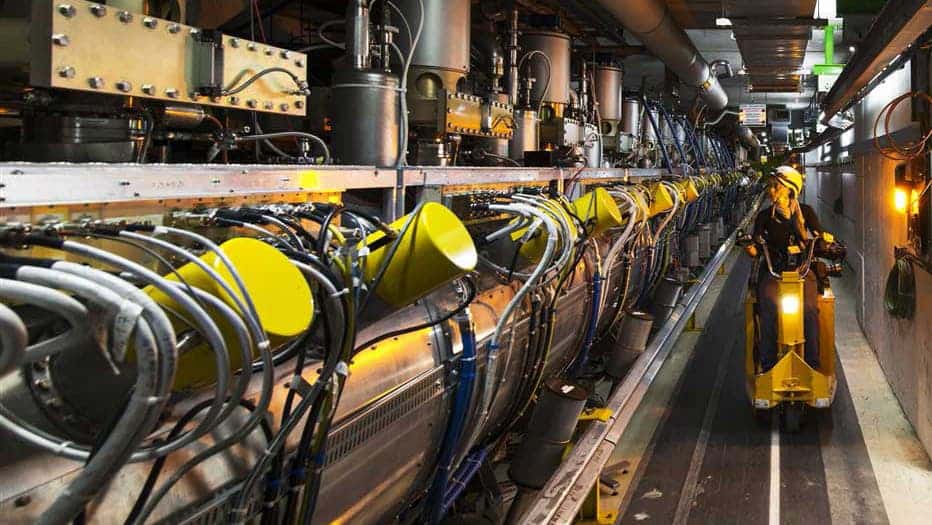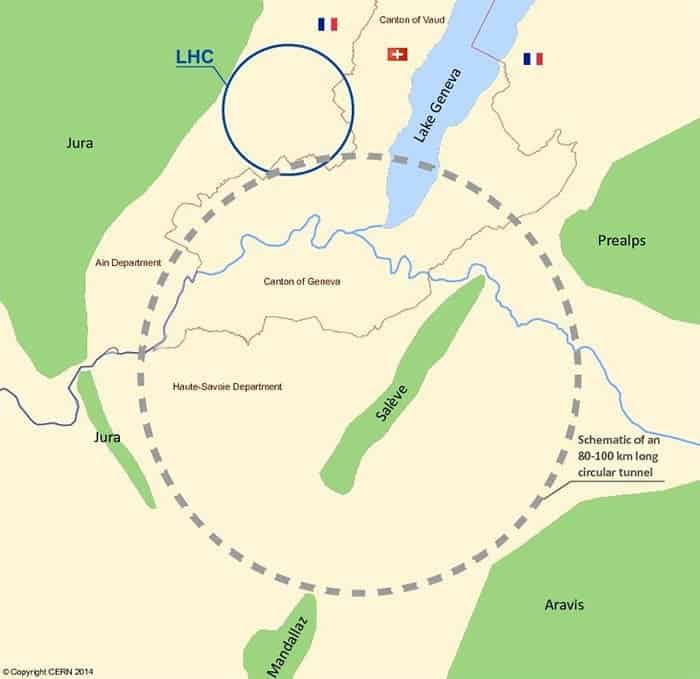
The Large Hadron Collider at the European particle physics laboratory CERN, near Geneva in Switzerland, is the most complex experimental facility ever built. Its 27-kilometre ring of superconducting magnets makes it the world’s largest and most powerful particle accelerator in the world. Since it first started up in 2008, the LHC has already made monumental contributions to physics. Without the LHC, it would’ve been impossible to confirm the existence of the now famous Higgs boson, the so-called ‘God particle’ thought to be responsible for lending things mass.
Surely, the future has many other scientific discoveries in store for the $4 billion scientific facility. But meanwhile, some of the world’s foremost physicists are already drafting plans for a new, improved LHC 2.0.
This week in Berlin, 500 scientists met to hammer out the new LHC or the Future Circular Collider (FCC), as they’ve named it. EuroCirCol, a four-year European-funded study, is responsible for tracing out the new particle accelerator. Some of the proposed upgrades so far include:
- An 80-100 kilometre-long circuit (50-62 miles) instead of the LHC’s 27 kilometres (17 miles). That’s three times bigger.
- It will be located so close to its predecessor on the France-Switzerland border that the two rings will literally overlap.
- Double-strength magnets will help smash protons and other particles with a strength of up to 100 Tera electron Volts, which is equivalent to 10 million lightning strikes all firing at the same point and seven times more powerful than the LHC.
- The number of Z bosons produced by FCC-ee (up to 1013), is expected to be almost six orders of magnitude larger than the number of Z bosons collected at LEP (2×107), and up to four orders of magnitude larger than that envisioned with a linear collider (a few 109).

The FCC will also likely require immense computing power and storage hardware. The LHC collides beams at 20 MHz and every collision is measured and is temporarily stored on hardware to be analyzed. Each recorded event is around 10 MB in size resulting in roughly 5 Zettabytes per year of data being processed. For comparison, the total permanently recorded data on Earth is 0.5 Zettabytes and the total amount of information analyzed by the entire planet is 10 Zettabytes per year.
“5% of the Universe is directly observable. The Standard Model of Particle Physics describes it precisely. What about the remaining 95%?,” a statement on the FCC website reads.
“Yet many questions about our Universe remain unanswered. Is there more matter in the Universe than what is visible? What is dark matter made of? What happened to antimatter after the Big Bang? Are there extra dimensions in the Universe and, if so, can we explore them? To get answers and find out more about our Universe, scientists have to carry out experiments in more powerful particle accelerators. The higher energy frontier will expand our horizons and may shed light to the missing pieces of the puzzle of Nature.”
The physicists reckon the upgrade that will smash particles at dazzling energies will help them find hidden particles that are possibly even heavier than the Hiss boson which LHC confirmed in 2012. On a more practical level, the FCC could lead to more radiation-resistant materials that can be used in nuclear reactors.
It took the LHC about 30 years to switch on since the first sketches on the drawing board in the 1980s to the last nut and bolt. The FCC team hopes to have a thorough plan worked out by next year but no one hopes to see it operational any sooner than 20 years from now.
Meanwhile, the LHC will be busy churning out particles and, in the process, advance our understanding of fundamental physics. Just earlier this year, it found five new subatomic particles. And the LHC is slated for an upgrade of its own when sometimes in the mid-2020s it will see new hardware meant to boost particle collision rate and accuracy. After the new upgrade is ready, it will change its name too into the High Luminosity Large Hadron Collider (HL-LHC).


